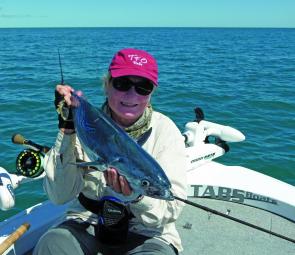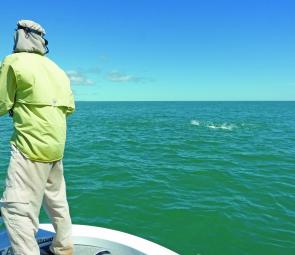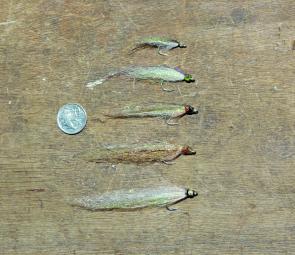As regular summer and autumn visitors to most offshore and bay waters long the Queensland coast, mac tuna are perfect for enjoying sport with the fly rod. Offshore and bay waters means that a boat is a necessity to tangle with these fish.
While not the largest of the tuna family to grace out waters, macs will still grow to 1m in length – although a good one will be around the 80cm mark – and as solid torpedos of strength and power are a true test of the fly anglers’ capability.
They take flies readily enough once a fly is cast into a feeding school but that’s not quite as easy as it sounds. The truth is that these fish are not always easy to sidle up to within casting range and seem to have a great penchant for sounding just as the first back cast is being made, only to come up again a short distance away when it suits them.
That aside, it’s my firm belief that mac tuna are truly erratic in their feeding habits. Being frustrated, at times, with my best efforts to approach a school only to be casting to dead water at the last instant, I have purposely kept well away from the action for a spell to see if a pattern might emerge that I could use to advantage. To my surprise, I found that the fish were feeding only in short bursts. A terrific patch of white water would erupt – birds diving, silvery backs in the sun – then… Nothing! They would move on for 80m, sometimes even less, only to repeat the show.
I did note a general trait and that was these fish will feed into the breeze, or into a making tide, which can be their undoing if the angler sits back just a little to confirm that this is occurring.
Once a feeding pattern emerges the trick is to first approach slowly and carefully into the action. Beware of hull slap! Then, if they sound on the boat’s approach, moving away quietly and taking up a position some distance up current or up wind will often pay dividends. For me, there is hardly a more satisfying situation for the fly angler to firstly ambush a school of mac tuna and then feeling that hard smack of a take. It’s heart-thumping stuff all the way.
From that instant onwards, things are going to happen quickly: fly line and then backing is going to disappear through the rod guides at a fast rate and should any obstruction occur to prevent said fly line and backing from running through the tip runner, a rapid break off is going to occur. On that note, ensure that the rod is tilted on it’s side while the reel is spinning and beware of loose clothing such as buttons and the like that might fall foul of fast moving backing. One thing that is standard fare with mac tuna is some impressive strength and speed when hooked.
Mac tuna will usually make a couple of hard initial runs, displaying a quite dogged refusal to come to the boat, which can often culminate in attempts to circle under the boat when the angler finally prevails with the ‘pump and wind’.
The trick when pumping a fish back is to keep the rod low, using it as a long lever, and not relying on tip action to pump the fish back. The tip’s action can be relied on to absorb any sudden shocks or jars from the fish but for the most part the rod is a long flexible lever, used with the butt and lower section really putting on the pressure. High sticking is definitely a no-no.
Now let’s talk about circling, which tuna are renowned for. In short, it’s not on! Once tuna of any persuasion start those circling tactics the fight is going to be prolonged greatly. Put simply, the fish is having a rest. To end those circling tactics the clue is to loosen the drag somewhat and drive the boat off a little distance while keeping the line fairly tight but not so tight the reel cannot turn. This results in the tuna being totally disorientated and a resumption of the hard pump and wind tactics should start to see some splashes on the surface, which, signifies that the angler is really starting to win. Be ready for one last run right at the boat, and don’t over do the drag setting at this point.
Mac tuna often mix with northern blue tuna and sometimes mackerel, so the chosen outfit should be able to handle all three fish. Accordingly, I recommend at least an 8wt outfit for the more expert angler, and a 9-10wt rig for anglers with not so much experience as hope.
The chosen reel is going to last best if it’s of a salt water standard, with a backing capacity of at least 200m, and have a drag with a very smooth, low inertia start up.
A store bought or home made leader of just a little less than rod’s length is handy, with a breaking strain from 6-10kg tip depending upon the angler’s skill.
Flies need to resemble baitfish with a selection of quite small ones from 1/0 through to 2/0 being suitable. Ideal are Surf Candys, polar fibre flies and other small baitfish patterns. My own flies are of no particular pattern but are styled similarly to small baitfish. I like a selection of sizes on hand as sometimes the fish are on hardy heads, which are around 10-12cm long.
With these sorts of flies we are trying to imitate small fish so it’s wise not to overdo the flashy colours or the size. Making your own flies is half the fun when chasing any of the tuna family and most fly tyers agree that few hooks are better for this style of fly fishing than Gamakatsu SL12S models given their great shape, needle sharpness and over all strength.
Reads: 3608
Denise Kampe with a fair mac tuna, which was great sport on her 9wt fly outfit.

In typical fashion, the author has cast his fly to the left, so the mac tuna are suddenly feeding to his right.

A selection of the author’s rough and ready mac tuna flies – they work!




